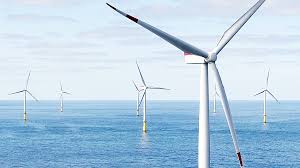New England States Unite to Procure up to 6 Gigawatts of Offshore Wind

The states of Massachusetts, Rhode Island, and Connecticut, on Oct.4 announced an offshore wind multi-state coordination memorandum of understanding for offshore wind in New England. The collaboration, the first of its kind in the U.S, aims to capture cost reductions by facilitating the development of large-scale, viable offshore wind projects, thereby enabling the acquisition of a potential capacity of up to 6 gigawatts in offshore wind energy. Furthermore, through their partnership, the states are committed to advancing regional economic development, creating high-paying, in-demand employment opportunities, and championing environmental justice and equity.
Offshore wind developers may submit multi-state project proposals, which will be considered by the respective procurement processes for selection in 2024. The final project selections will be contingent on each state’s individual evaluation of the proposals, considering factors such as costs, benefits to ratepayers, and other specified criteria in their respective requests for proposals. In addition, a combination of two or three states may agree to jointly select a multi-state proposal, up to the procurement authority of each state, and divide the expected megawatts and renewable energy certificates from a single project accordingly.
The Biden administration and East Coast states have stepped up efforts to support offshore wind development and harness the potential of carbon-free electricity to meet ambitious clean energy goals. The Biden administration has established a goal to deploy 30 gigawatts of offshore wind in the U.S. by 2030. Recently, the Departments of the Interior and Energy released a detailed transmission action proposal to realize the ample potential of Atlantic offshore wind energy. The action plan sets out bold strategies that will speed up the investment and development in offshore wind energy and strengthen the domestic supply chain. The administration has also announced several investment and funding opportunities. These include access to $3 billion in funding for offshore wind projects through the Department of Energy’s Innovative Energy Loan Guarantee Program and $230 million in funding opportunities for port authorities and other applicants for infrastructure-related projects through the Department of Transportation’s Maritime Administration.
Despite these significant developments, it’s important to acknowledge that the U.S. offshore wind industry still faces a range of challenges. These include opposition due to concerns about potential environmental and economic impacts, the increasing costs associated with projects, and ongoing delays, even though several projects have achieved major milestones.
The MOU represents a collaborative agreement among the Massachusetts Department of Energy Resources, the Connecticut Department of Energy & Environmental Protection, and the Rhode Island Office of Energy Resources. On the same day, Connecticut Governor Ned Lamont announced the release of the state’s first strategic roadmap for economic development in the offshore wind industry, supported by a newly-formed public-private called Connecticut Wind Collaborative. The roadmap identifies four strategic pillars, each with priority actions to focus efforts going forward.
EnerKnol Pulses like this one are powered by the EnerKnol Platform—the first comprehensive database for real-time energy policy tracking. Sign up for a free trial below for access to key regulatory data and deep industry insights across the energy spectrum.
ACCESS FREE TRIAL